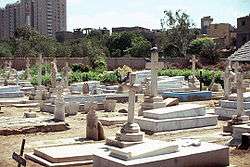Gora Qabaristan, Karachi

The Gora Qabaristan (Urdu: گورا قبرِستان; also spelled as Gora Kabristan), or Gora Cemetery, literally transliterated as White (skinned) graveyard[1] is Karachi's only operational Christian cemetery.
History
The original consecration of the Karachi Christian Cemetery was in 1845 during colonial rule but there is a tombstone set in the wall near the main gate of the cemetery bearing the date 1843.
After the independence in 1947, the British High Commission in Karachi invited the members of the various Christian bodies to form the Karachi Christian Cemeteries Board.[2]
In May 2002, the mutilated body of American journalist Daniel Pearl was found in the graveyard. No one knows how it was dumped there.[3]
Location
It is located on main Shahrah-e-Faisal. [3]
Division
Until around 1981, the cemetery was divided into two parts, Protestant and Catholic. However, since then, the wall separating them was removed and the two merged.
Management
The Karachi Christian Cemetery Board manages its affairs.
Over time the condition of the cemetery has deteriorated.[1] In 1995, a group called CARE (Caring, putting into Action, and Restoring the Environmental degradation of the cemetery), made up of people from all parishes and churches, made it their objective to make the cemetery a clean and peaceful resting place for the departed.
Among the problems identified requiring attention were: stopping the continuous flow of sewage into the cemetery grounds; the cutting and clearing of weeds almost 8 feet high, removal of garbage piled up at least 3 feet high over an area of almost 2000 square yards along the West wall; the construction of a concrete wall (estimated to be 6,000 feet), and a permanent pumping station to drain out rain water during the monsoons.[4]
In 2006 the cemetery continues to be desecrated with boys of the surrounding localities playing cricket and football here causing damage to the graves.[5]
Burial services
From 1885, burial services have been performed by a family firm, Anthony Coutinho & Company. The office still exists on Shahrah-e-Iraq, near St. Patrick's Cathedral, but it has all but stopped functioning. More recently, the St. Joseph's Association, a diocesan organization that organises burials has taken over this function.[6]
Polish memorial

Following the Soviet invasion of Poland, hundreds of thousands of Poles were deported to Soviet labor camps. Between 1942-1945 some 3,000 refugees were given refuge in Karachi.[7] In memory of the 58 Polish citizens who died in Karachi in the 1940s, a memorial has been erected by the Polish government.[8] It lists the names of all 58 individuals.[8]
The most prominent Pole buried in the cemetery is Air Commodore Władysław Turowicz who played a key role in Pakistan's aviation and aerospace industry.
Renovations
The city’s district government in 2011 installed two new gates and paved the pathways inside the graveyard.[9]
In 2014 a giant cross, said to be one of the highest in the region - about 43m, has been constructed just inside the cemetery wall. The construction of the cross has been paid for by a Christian businessman, Parvez Henry Gill.[1]
References
- 1 2 3 BBC News 1 September 2015
- ↑ "The Karachi Christian Cemetery".
- 1 2 Zakaria R. The Upstairs Wife, Beacon Press, 2015.
- ↑ The Christian Voice, Karachi, December 24, 1995
- ↑ Dawn 20 July 2006
- ↑ "St. Joseph's Association".
- ↑ KARACHI: Cemetery renovated
- 1 2 Consulate General of the Republic of Poland in Karachi - Consulate's Activity in '2005
- ↑ UCANews 4 November 2011